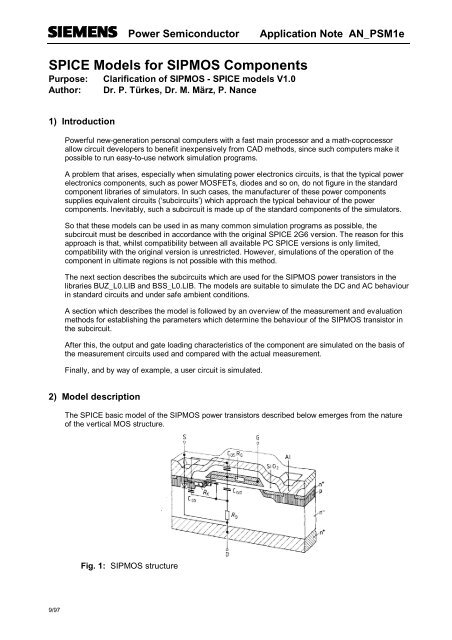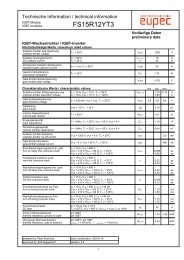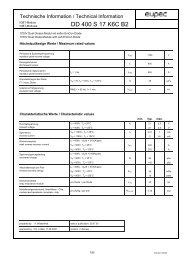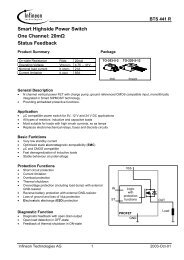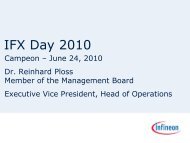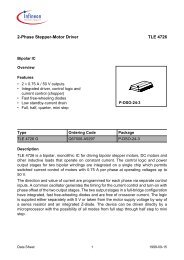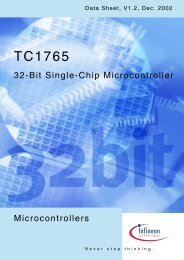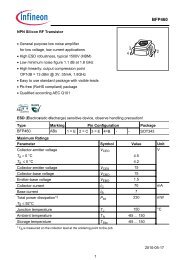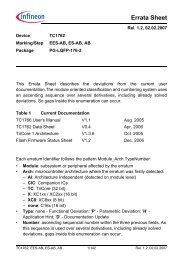SPICE Models for SIPMOS Components - Infineon
SPICE Models for SIPMOS Components - Infineon
SPICE Models for SIPMOS Components - Infineon
Create successful ePaper yourself
Turn your PDF publications into a flip-book with our unique Google optimized e-Paper software.
9/97<br />
Power Semiconductor Application Note AN_PSM1e<br />
<strong>SPICE</strong> <strong>Models</strong> <strong>for</strong> <strong>SIPMOS</strong> <strong>Components</strong><br />
Purpose: Clarification of <strong>SIPMOS</strong> - <strong>SPICE</strong> models V1.0<br />
Author: Dr. P. Türkes, Dr. M. März, P. Nance<br />
1) Introduction<br />
Powerful new-generation personal computers with a fast main processor and a math-coprocessor<br />
allow circuit developers to benefit inexpensively from CAD methods, since such computers make it<br />
possible to run easy-to-use network simulation programs.<br />
A problem that arises, especially when simulating power electronics circuits, is that the typical power<br />
electronics components, such as power MOSFETs, diodes and so on, do not figure in the standard<br />
component libraries of simulators. In such cases, the manufacturer of these power components<br />
supplies equivalent circuits (‘subcircuits’) which approach the typical behaviour of the power<br />
components. Inevitably, such a subcircuit is made up of the standard components of the simulators.<br />
So that these models can be used in as many common simulation programs as possible, the<br />
subcircuit must be described in accordance with the original <strong>SPICE</strong> 2G6 version. The reason <strong>for</strong> this<br />
approach is that, whilst compatibility between all available PC <strong>SPICE</strong> versions is only limited,<br />
compatibility with the original version is unrestricted. However, simulations of the operation of the<br />
component in ultimate regions is not possible with this method.<br />
The next section describes the subcircuits which are used <strong>for</strong> the <strong>SIPMOS</strong> power transistors in the<br />
libraries BUZ_L0.LIB and BSS_L0.LIB. The models are suitable to simulate the DC and AC behaviour<br />
in standard circuits and under safe ambient conditions.<br />
A section which describes the model is followed by an overview of the measurement and evaluation<br />
methods <strong>for</strong> establishing the parameters which determine the behaviour of the <strong>SIPMOS</strong> transistor in<br />
the subcircuit.<br />
After this, the output and gate loading characteristics of the component are simulated on the basis of<br />
the measurement circuits used and compared with the actual measurement.<br />
Finally, and by way of example, a user circuit is simulated.<br />
2) Model description<br />
The <strong>SPICE</strong> basic model of the <strong>SIPMOS</strong> power transistors described below emerges from the nature<br />
of the vertical MOS structure.<br />
Fig. 1: <strong>SIPMOS</strong> structure
Power Semiconductor Application Note AN_PSM1e<br />
No detailed description of such a vertical MOS structure is given here; please refer to the relevant<br />
literature.<br />
Network elements that emerge from the technological structure have already been drawn in the crosssection<br />
of the component. For example, the drift distance is designated as resistance Rd.<br />
The <strong>SPICE</strong> subcircuit <strong>for</strong> the <strong>SIPMOS</strong> transistor arising from the component cross-section above is<br />
shown in Fig. 2. The various voltage interdependencies have been taken into account.<br />
n-channel enhancement n-channel depletion<br />
Fig. 2: The <strong>SIPMOS</strong> Level-1 <strong>SPICE</strong> transistor models<br />
(The basic structure of the subcircuit applies both to power and small-signal transistors)<br />
The network consists of equivalent components which describe on the one hand the DC and on the<br />
other the AC and transient behaviour of the transistor. It is important to distinguish between the<br />
following subcomponents:<br />
DC-relevant subcomponents:<br />
a) The inner MOSFET MBUZ describes the characteristic curves of the component and its transfer<br />
characteristic.<br />
b) The source resistance RS is <strong>for</strong> negative feedback to the gate at high currents.<br />
c) The drain resistance, which may be voltage-dependent, is represented as ’depletion mode<br />
MOSFET’ MVRD. The voltage dependence of the drain resistance is caused by modulation of<br />
the conductivity in the drain region as a consequence of a field effect of the drain-source pn<br />
junction. This field effect narrows the current path between the source islands of the MOSFET<br />
when the drain-source voltage is applied; see Figure 1.<br />
The sum of the resistances MBUZ, RS and MVRD gives the ‘on-state resistance’ of the<br />
component.<br />
d) The reverse diode DREV is <strong>for</strong> backward operation of the transistor.<br />
AC-relevant subcomponents<br />
a) The constant gate-source capacitance CGS models the switching time-constants.<br />
b) The voltage-dependent gate-drain capacitance (or Miller capacitance) COX, together with the<br />
diode DGD, describe the modelling of the gate charging process. COX is provided as a con-<br />
2 AN_M1.DOC
Power Semiconductor Application Note AN_PSM1e<br />
stant capacitance to describe the gate-drain capacitance in the off-state and DGD as the<br />
barrier-layer capacitance <strong>for</strong> this in the on-state. Depending on the working point, these two<br />
parts of the gate-drain capacitance are switched to M2 and M3 by the two MOSFETs.<br />
This means that the only purpose of subcomponents M2 and M3 is to act as auxiliary components<br />
to set the working point of the voltage-dependent gate-drain capacitance.<br />
d) The barrier-layer capacitance Cjo and the transfer time-constant TT of the reverse diode DREV<br />
fully model the switching time-constants.<br />
e) The lead inductances LG, LD and LS influence the rates at which the currents rise. In particular,<br />
the source inductance LS causes current feedback to the gate circuit.<br />
f) The auxiliary voltage source VGC sets the capacitance process.<br />
This auxiliary voltage source makes it possible to take account of the influence of technological<br />
steps which reduce the starting voltage of the MOSFET and at the same time shift the<br />
capacitance curves toward higher voltages. This circuit variant is not used in all component<br />
models. Such an auxiliary voltage source is used, <strong>for</strong> instance, in the types known as ’logic<br />
level’ types.<br />
In these, a constant charge, which can be represented according to the displacement law as a<br />
fixed voltage source, is applied to the MOS capacitor.<br />
g) Gate resistance RG<br />
The gate resistance delays the recharging of the MOS capacitor during switching. The timeconstant<br />
resulting from the combination of RG and CGS is the measure <strong>for</strong> the setting of the<br />
resistance RG. The value of RG can only be determined directly with difficulty.<br />
It is there<strong>for</strong>e suggested, as far as use of the model is concerned, that the switching<br />
time-constant should be adapted to the conditions by means of external resistances in<br />
the gate circuit.<br />
The next section explains how to measure and calculate the parameters which describe the<br />
equivalent components.<br />
3) Parameter extraction<br />
a) Parameters from the MOSFET input characteristic I d = I d (U g ) at U ds = const<br />
The input characteristic of the component can be drawn with a characteristic recorder. Data<br />
collection is simplified if a recorder with digital memory and a digital output is used.<br />
The parameters to be extracted depend mainly on the basic model used to describe the<br />
MOSFET current as a function of the applied voltages.<br />
The basic model chosen <strong>for</strong> the inner MOSFET of this <strong>SIPMOS</strong>-<strong>SPICE</strong> description is<br />
introduced in the literature as a ’LEVEL 1’ model and describes the MOSFET transfer function<br />
Id = Id(Ug,Uds) as a function of only two parameters:<br />
i) I d = Kp*((U gs - U t )*U ds - U ds 2 /2) triode region<br />
ii) I d = Kp/2*(U gs - U t ) 2<br />
saturation region<br />
If current negative feedback via a source resistance Rs is to be taken into account, equation ii)<br />
must be modified as follows:<br />
iii) I<br />
d<br />
= Kp/2*(U<br />
g<br />
- U<br />
t<br />
- I<br />
d<br />
*R<br />
s<br />
) 2<br />
Using this equation and a ’least mean square’ fit, the parameters transfer function Kp, starting<br />
voltage Ut of the MOSFET and the value of the source resistance Rs are determined. Taking<br />
the BUZ 12 as an example, this process is represented by comparison of the measurement<br />
curve and the function i) adapted to it (Fig. 3). The corresponding evaluation routine is<br />
programmed with the aid of the mathematical utility program MATHCAD.<br />
3 AN_M1.DOC
√<br />
I d<br />
A<br />
Power Semiconductor Application Note AN_PSM1e<br />
10<br />
8<br />
6<br />
4<br />
2<br />
0<br />
3.5 4 4.5 5 5.5 6 6.5 7<br />
Fig. 3: Evaluation of the transfer characteristic<br />
U DS [V]<br />
b) Parameters from the characteristic I d = I d (U g = U cc )<br />
UG = UDS<br />
After evaluation of the transfer characteristic, the parameters Kp, Vt and Rs are known. This<br />
makes it possible to calculate a characteristic Id (Ug,Uds) corresponding to the subcircuit (Fig. 2),<br />
in order to determine the voltage-dependent drain resistance RD. In other words, the voltagedependent<br />
resistance is determined as a current/voltage characteristic from the comparison of the<br />
calculated and the simulated output characteristic.<br />
I d [A]<br />
50<br />
40<br />
30<br />
20<br />
10<br />
0<br />
standard<br />
DMOS model<br />
(<strong>SPICE</strong>)<br />
measured<br />
device<br />
characteristic<br />
UG = const.<br />
0 0.25 0.5 0.75 1 1.25 1.5<br />
U DS [V]<br />
Fig. 4: Comparison of the calculated and the measured output characteristics<br />
at Ug = 20V to determine the drain resistance (Example: BUZ12)<br />
4 AN_M1.DOC
I d [A]<br />
Power Semiconductor Application Note AN_PSM1e<br />
50<br />
40<br />
30<br />
20<br />
10<br />
0<br />
0 0.25 0.5 0.75 1 1.25 1.5<br />
U DS (MVRD) [V]<br />
Fig. 5: Drain resistance characteristic determined from the curves of Fig. 4<br />
Apart from this, voltage dependency of the drain resistance may only be expected with components<br />
having higher blocking voltages. Such behaviour is only weakly present in high-current types. Here<br />
it is sufficient to include a constant resistance in the network instead of the auxiliary transistor<br />
MVRD. This constant drain resistance can be worked out from the known on-state conductivity of<br />
the component, the extracted source resistance and the MOSFET transfer characteristic.<br />
c) Characteristic of the reverse diode<br />
Semi-logarithmic extrapolation of the diode <strong>for</strong>ward current gives the reverse current IS and the<br />
’ideality factor’ N, which characterise the <strong>for</strong>ward characteristic:<br />
iv) I di = IS*(exp(U di /(N*UT)) - 1) where UT is the temperature voltage.<br />
d) Parameters from AC characteristics<br />
Capacitance parameters:<br />
The basis <strong>for</strong> the measurement and thus <strong>for</strong> the evaluation is the subcircuit of the three<br />
capacitances CDS and CGD of the MOS part and CJ of the reverse diode, in a star arrangement.<br />
The measurements are made in configurations familiar from the application notes of the<br />
capacitance bridge manufacturers. The measurement frequency is set to 1 MHz and the drainsource<br />
voltage is varied in the working range at constant gate voltage. The result is a family of<br />
characteristics <strong>for</strong> the voltage-dependent capacitances.<br />
A typical family of measurement curves <strong>for</strong> CGS, CGD and CDS is shown in Figure 6.<br />
5 AN_M1.DOC
Power Semiconductor Application Note AN_PSM1e<br />
10000<br />
C [pF]<br />
1000<br />
100<br />
C DS<br />
C GD<br />
C GS<br />
0 5 10 15 20 25 30<br />
U DS [V]<br />
Fig. 6: Voltage-dependent capacitances CGS, CGD and CDS (BUZ100S)<br />
It is evident even here that CGS is almost independent of the voltage, whereas CDS and<br />
CGD show distinct voltage-dependent behaviour. The value of CGS can be taken directly<br />
from such a measurement.<br />
The two voltage-dependent capacitances CDS and CGD must now be introduced into the<br />
network model as follows:<br />
Taking the <strong>SPICE</strong>-specific description of a barrier layer capacitance in the <strong>SPICE</strong> diode<br />
model as a starting point, it would seem natural to adapt the measured capacitance curves to<br />
the <strong>SPICE</strong> barrier layer model. For the behaviour of CDS, this is easily done by adapting the<br />
function<br />
v) CDS = CDS0 * ( 1 + V<br />
di<br />
/V<br />
j<br />
) m<br />
built into <strong>SPICE</strong> in order to determine the parameters CDS0, Vj, m.<br />
The procedure <strong>for</strong> the gate-drain capacitance is exactly the same. The measured behaviour is<br />
adapted to the function v) and the corresponding parameters are determined.<br />
However, because of the properties of a MOS capacitance, it is essential to ensure that, when<br />
the gate-drain voltage is negative, there is a constant capacitance COX. This is achieved by<br />
the auxiliary circuit with the two MOSFETs M2 and M3, which switch in the barrier-layer<br />
capacitance of the diode DGD when the drain-gate voltage is positive and the constant<br />
capacitance COX when the drain-gate voltage is negative. Initially, the value of the parameter<br />
COX is the gate-drain capacitance at Ugd = 0V. The MOSFET parameters <strong>for</strong> M2 and M3<br />
must be set so that the MOSFETs switch on in the region of 0V and then exhibit a low<br />
resistance. Dynamic parameters are not transfered to these MOSFETs.<br />
e) Parameters from transient measurements, the transit time TT<br />
In reverse operation of the MOSFET, charge carriers are injected into the reverse diode. For<br />
this case, it is necessary to determine the parameter TT of the <strong>SPICE</strong> diode in order to be<br />
able to describe the decay of charge carriers after recommutation of the diode. The<br />
parameter TT is determined by measuring the carrier charge at the reverse diode.<br />
6 AN_M1.DOC
Power Semiconductor Application Note AN_PSM1e<br />
f) The lead inductances LG, LS, LD<br />
Intrinsic component inductances are determined by measuring the lengths and cross-sections<br />
of the leads and then calculating the self-inductance, as derived in text books.<br />
The parameter extraction method outlined here provides a simple way of determining the<br />
parameter values needed <strong>for</strong> modelling the subcircuit.<br />
The next section shows that, with the parameters determined, the <strong>SIPMOS</strong> power transistor model<br />
presented here is capable of correctly simulating both the measurement results of the parameter<br />
extraction circuits and an inverter circuit with inductive load.<br />
4) Limits of the model<br />
The simplified approach to <strong>SPICE</strong> modelling of <strong>SIPMOS</strong> transistors comes up against its limits<br />
when the model is operated in a circuit in a range in which, in reality, the avalanche breakdown of<br />
the reverse diode occurs. None of the phenomena that lie beyond the exponential rise of the<br />
reverse blocking current, such as the activation of the parasitic bipolar transistor (not shown on the<br />
cross-section), are reproduced by the <strong>SPICE</strong> simulation. Moreover, the effect of component<br />
temperature rise is not taken into account. This problem can be tackled by including in the <strong>SPICE</strong><br />
model parameters determined at a higher temperature.<br />
5) Modelling examples<br />
The procedure <strong>for</strong> simulating typical circuits is explained below using a number of examples. First<br />
the DC output characteristics are simulated, then transient characteristics are determined in some<br />
standard circuits. Finally a DC chopper converter circuit is simulated in order to demonstrate how<br />
powerful these models are.<br />
i) Simulation of the output characteristic<br />
Standard setup with drain-source voltage sweep and the gate voltage as a parameter.<br />
The gate and the drain of the model network are connected to separate power supplies. This is the<br />
simplest test circuit.<br />
Fig. 7: Test circuit to simulate the output and transfer characteristics<br />
When simulating the output characteristic and the transfer characteristic, only the DC card is used<br />
<strong>for</strong> simulation control. The output and transfer characteristics are simulated in a range which<br />
corresponds to the range of application of the measurements. With suitably prepared measurement<br />
data, the result of the simulation is comparable to the result obtained by measurement.<br />
7 AN_M1.DOC
Power Semiconductor Application Note AN_PSM1e<br />
Fig. 8: Comparison of simulation and measurement, using the example of the<br />
output characteristic field at different gate voltages of the BUZ41AL<br />
(IS-<strong>SPICE</strong> result)<br />
ii) Gate charge<br />
Simulation of the measurement circuit as shown in the data book<br />
A transient simulation is demonstrated using the gate charge simulation. The essential parts of<br />
the measurement circuit in the simulation correspond to the actual measurement setup. This<br />
permits direct comparison of the simulated and the measured results when the simulation is<br />
complete. The component used in this measurement circuit is the BUZ 12 AL.<br />
Fig. 9: Measurement circuit <strong>for</strong> determining the behaviour of the gate<br />
voltage<br />
<strong>for</strong> operation with constant load current and constant gate control.<br />
The equivalent circuit shown here reveals an essential point <strong>for</strong> the simulation of complex<br />
circuits. The circuit to be simulated is first reduced to its essential elements.<br />
The simulation parameters which determine the accuracy of calculation <strong>for</strong> current, voltage and<br />
charge (abstol = tolerance on calculation of the absolute current, vntol = tolerance on calculation<br />
of absolute voltage and chgtol = tolerance on calculation of absolute charge) are then adapted to<br />
the problem. This step calls <strong>for</strong> a certain amount of caution and experience.<br />
8 AN_M1.DOC
Power Semiconductor Application Note AN_PSM1e<br />
The last step is the definition of the transient control instruction, in which both the final value and<br />
the time control step width are set.<br />
Fig. 10: Result of gate charge simulation (1) on the BUZ12AL and comparison with<br />
the measured gate charge curve (2)<br />
iii) Inverter with inductive load<br />
This case shows how a <strong>SIPMOS</strong>-<strong>SPICE</strong> model is used in a DC chopper converter circuit.<br />
In such a circuit, an inductive load is charged to a particular value of current via the pulse control<br />
factor. During the „off“-phases of the switching transistor the inductive load drives the current<br />
through a second transistor connected as a free-wheeling diode.<br />
BUZ12AL<br />
BUZ12AL<br />
Fig. 11: DC chopper converter circuit with BUZ12AL<br />
One result of simulating the starting of a DC chopper converter circuit is shown in Fig. 12. As<br />
expected, the current (curve 0) rises with time in accordance with the coil values. At the same<br />
time, the drain-source voltage of the switched-on MOSFET increases. The power dissipation<br />
could thus be calculated from the two curves, leading to an estimate of the temperature rise of<br />
the component.<br />
This simulation also requires the simulation parameters <strong>for</strong> current, voltage and charge (abstol,<br />
vntol and chgtol) to be set under the conditions mentioned above.<br />
9 AN_M1.DOC
Appendix:<br />
Power Semiconductor Application Note AN_PSM1e<br />
time in sec<br />
Fig. 12: Coil current (0) and drain-source voltage (2) in a DC chopper converter<br />
circuit as in Fig. 11<br />
Note: The voltage peak in the simulation results from a numerical instability<br />
a) Subcircuit of BUZ12AL (high-current MOSFET)<br />
.SUBCKT BUZ12AL 1 2 3 */ 1:Gate 2: Source 3:Drain /*<br />
LS 5 2 7N<br />
LD 83 3 5N<br />
RG 4 11 5.5M<br />
RS 5 76 40M<br />
D12AL 76 83 DREV<br />
.MODEL DREV D CJO=2.925N RS=20M TT=500N IS=300P BV=50<br />
M12AL 71 11 76 76 MBUZ<br />
.MODEL MBUZ NMOS VTO=2.12 KP=24.66<br />
M2 11 71 8 8 MSW<br />
.MODEL MSW NMOS VTO=0.001 KP=10<br />
M3 71 11 8 8 MSW<br />
COX 11 8 5.194N<br />
DGD 8 71 DCGD<br />
.MODEL DCGD D CJO=5.194N M=0.516 VJ=0.072<br />
CGS 76 11 2.1N<br />
RDR 71 83 10M<br />
LG 4 1 7N<br />
.ENDS<br />
b) Subcircuit of BUZ41A (high-voltage MOSFET)<br />
.SUBCKT BUZ41A 1 2 3 */ 1:Gate 2: Source 3:Drain /*<br />
LS 5 2 7N<br />
LD 87 3 5N<br />
RG 4 11 5.5M<br />
RS 5 76 34M<br />
D41A 76 87 DREV<br />
.MODEL DREV D CJO=420P RS=20M TT=500N IS=300P BV=500<br />
M41A 86 11 76 76 MBUZ<br />
.MODEL MBUZ NMOS VTO=3.313 KP=7.66<br />
M2 11 86 8 8 MSW<br />
.MODEL MSW NMOS VTO=0.001 KP=10<br />
M3 86 11 8 8 MSW<br />
10 AN_M1.DOC
Power Semiconductor Application Note AN_PSM1e<br />
COX 11 8 2.5N<br />
DGD 8 86 DCGD<br />
.MODEL DCGD D CJO=250P M=0.675 VJ=1.301<br />
CGS 76 11 870P<br />
MDR 87 86 86 86 MVRD<br />
.MODEL MVRD NMOS VTO=-13.1 KP=0.068<br />
LG 4 1 7N<br />
.ENDS<br />
c) Subcircuit of BSP149 (n-channel depletion MOSFET)<br />
SUBCKT BSP149 1 2 3 */ 1:Gate 2: Source 3:Drain /*<br />
LG 95 1 7N<br />
LS 5 2 7N<br />
LD 97 3 5N<br />
RG 95 99 5.5M<br />
RS 5 76 578M<br />
D149 76 97 DREV<br />
.MODEL DREV D CJO=0.03N RS=20M TT=35N IS=300P BV=200<br />
M149 98 99 76 76 MBUZ<br />
.MODEL MBUZ NMOS VTO=-1.334 KP=1.022<br />
M2 87 98 8 8 MSW<br />
.MODEL MSW NMOS VTO=0.001 KP=5<br />
M3 98 87 8 8 MSW<br />
COX 87 8 0.08N<br />
DGD 8 98 DCGD<br />
.MODEL DCGD D CJO=59P M=0.542 VJ=0.979<br />
CGS 76 99 225P<br />
VGC 87 99 3<br />
MHELP 98 98 97 98 MVRD<br />
.MODEL MVRD NMOS VTO=-16.18 KP=0.34<br />
.ENDS<br />
d) Control instruction <strong>for</strong> transient simulation of the DC chopper converter<br />
* Width and final value of time step<br />
.TRAN 10U 2M<br />
* Parameters <strong>for</strong> transient analysis and calculation accuracy <strong>for</strong> voltage (vntol), current<br />
(abstol) and charge (chgtol)<br />
.OPTIONS LIMPTS=5000 ITL1=2000 ITL4=1200 ITL5=150000<br />
+ VNTOL=1M ABSTOL=1U CHGTOL=10P<br />
11 AN_M1.DOC


